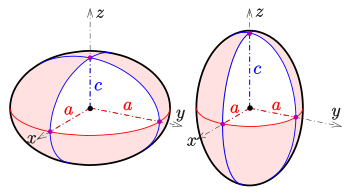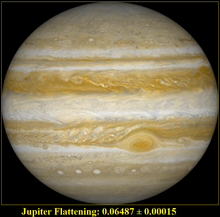Spheroid

| ||
| oblate | prolate | |
|---|---|---|
Aspheroid,also known as anellipsoid of revolutionorrotational ellipsoid,is aquadricsurfaceobtained byrotatinganellipseabout one of its principal axes; in other words, anellipsoidwith two equalsemi-diameters.A spheroid hascircular symmetry.
If the ellipse is rotated about itsmajor axis,the result is aprolate spheroid,elongated like arugby ball.TheAmerican footballis similar but has a pointier end than a spheroid could. If the ellipse is rotated about itsminor axis,the result is anoblate spheroid,flattened like alentilor a plainM&M.If the generating ellipse is a circle, the result is asphere.
Due to the combined effects ofgravityandrotation,thefigure of the Earth(and of allplanets) is not quite a sphere, but instead is slightlyflattenedin the direction of its axis of rotation. For that reason, incartographyandgeodesythe Earth is often approximated by an oblate spheroid, known as thereference ellipsoid,instead of a sphere. The currentWorld Geodetic Systemmodel uses a spheroid whose radius is 6,378.137 km (3,963.191 mi) at theEquatorand 6,356.752 km (3,949.903 mi) at thepoles.
The wordspheroidoriginally meant "an approximately spherical body", admitting irregularities even beyond the bi- or tri-axial ellipsoidal shape; that is how the term is used in some older papers on geodesy (for example, referring to truncated spherical harmonic expansions of theEarth's gravitygeopotential model).[1]
Equation
[edit]
The equation of a tri-axial ellipsoid centred at the origin with semi-axesa,bandcaligned along the coordinate axes is
The equation of a spheroid withzas thesymmetry axisis given by settinga=b:
The semi-axisais the equatorial radius of the spheroid, andcis the distance from centre to pole along the symmetry axis. There are two possible cases:
- c<a:oblate spheroid
- c>a:prolate spheroid
The case ofa=creduces to a sphere.
Properties
[edit]Area
[edit]An oblate spheroid withc<ahassurface area
The oblate spheroid is generated by rotation about thez-axis of an ellipse with semi-major axisaand semi-minor axisc,thereforeemay be identified as theeccentricity.(Seeellipse.)[2]
A prolate spheroid withc>ahas surface area
The prolate spheroid is generated by rotation about thez-axis of an ellipse with semi-major axiscand semi-minor axisa;therefore,emay again be identified as theeccentricity.(Seeellipse.)[3]
These formulas are identical in the sense that the formula forSoblatecan be used to calculate the surface area of a prolate spheroid and vice versa. However,ethen becomesimaginaryand can no longer directly be identified with the eccentricity. Both of these results may be cast into many other forms using standard mathematical identities and relations between parameters of the ellipse.
Volume
[edit]The volume inside a spheroid (of any kind) is
IfA= 2ais the equatorial diameter, andC= 2cis the polar diameter, the volume is
Curvature
[edit]Let a spheroid be parameterized as
whereβis thereduced latitudeorparametric latitude,λis thelongitude,and−π/2<β< +π/2and−π <λ< +π.Then, the spheroid'sGaussian curvatureis
and itsmean curvatureis
Both of these curvatures are always positive, so that every point on a spheroid is elliptic.
Aspect ratio
[edit]Theaspect ratioof an oblate spheroid/ellipse,c:a,is the ratio of the polar to equatorial lengths, while theflattening(also called oblateness)f,is the ratio of the equatorial-polar length difference to the equatorial length:
The firsteccentricity(usually simply eccentricity, as above) is often used instead of flattening.[4]It is defined by:
The relations between eccentricity and flattening are:
All modern geodetic ellipsoids are defined by the semi-major axis plus either the semi-minor axis (giving the aspect ratio), the flattening, or the first eccentricity. While these definitions are mathematically interchangeable, real-world calculations must lose some precision. To avoid confusion, an ellipsoidal definition considers its own values to be exact in the form it gives.
Occurrence and applications
[edit]The most common shapes for the density distribution of protons and neutrons in anatomic nucleusarespherical,prolate, and oblate spheroidal, where the polar axis is assumed to be the spin axis (or direction of the spinangular momentumvector). Deformed nuclear shapes occur as a result of the competition betweenelectromagneticrepulsion between protons,surface tensionandquantumshell effects.
Spheroids are common in3D cell cultures. Rotating equilibrium spheroids include theMaclaurin spheroidand theJacobi ellipsoid. Spheroidis also a shape of archaeological artifacts.
Oblate spheroids
[edit]
The oblate spheroid is the approximate shape of rotatingplanetsand othercelestial bodies,including Earth,Saturn,Jupiter,and the quickly spinning starAltair.Saturn is the most oblate planet in theSolar System,with aflatteningof 0.09796. Seeplanetary flatteningandequatorial bulgefor details.
EnlightenmentscientistIsaac Newton,working fromJean Richer's pendulum experiments andChristiaan Huygens's theories for their interpretation, reasoned that Jupiter andEarthare oblate spheroids owing to theircentrifugal force.[5][6]Earth's diverse cartographic and geodetic systems are based onreference ellipsoids,all of which are oblate.
Prolate spheroids
[edit]
The prolate spheroid is the approximate shape of the ball in several sports, such as in therugby ball.
Severalmoonsof the Solar System approximate prolate spheroids in shape, though they are actuallytriaxial ellipsoids.Examples areSaturn's satellitesMimas,Enceladus,andTethysandUranus' satelliteMiranda.
In contrast to being distorted into oblate spheroids via rapid rotation, celestial objects distort slightly into prolate spheroids viatidal forceswhen they orbit a massive body in a close orbit. The most extreme example is Jupiter's moonIo,which becomes slightly more or less prolate in its orbit due to a slight eccentricity, causing intensevolcanism.The major axis of the prolate spheroid does not run through the satellite's poles in this case, but through the two points on its equator directly facing toward and away from the primary. This combines with the smaller oblate distortion from the synchronous rotation to cause the body to become triaxial.
The term is also used to describe the shape of somenebulaesuch as theCrab Nebula.[7]Fresnel zones,used to analyze wave propagation and interference in space, are a series of concentric prolate spheroids with principal axes aligned along the direct line-of-sight between a transmitter and a receiver.
Theatomic nucleiof theactinideandlanthanideelements are shaped like prolate spheroids.[8]In anatomy, near-spheroid organs such astestismay be measured by theirlong and short axes.[9]
Many submarines have a shape which can be described as prolate spheroid.[10]
Dynamical properties
[edit]For a spheroid having uniform density, themoment of inertiais that of an ellipsoid with an additional axis of symmetry. Given a description of a spheroid as having amajor axisc,and minor axesa = b,the moments of inertia along these principal axes areC,A,andB.However, in a spheroid the minor axes are symmetrical. Therefore, our inertial terms along the major axes are:[11]
whereMis the mass of the body defined as
See also
[edit]- Ellipsoidal dome
- Equatorial bulge
- Great ellipse
- Lentoid
- Oblate spheroidal coordinates
- Ovoid
- Prolate spheroidal coordinates
- Rotation of axes
- Translation of axes
References
[edit]- ^Torge, Wolfgang (2001).Geodesy(3rd ed.).Walter de Gruyter.p. 104.ISBN9783110170726.
- ^A derivation of this result may be found at"Oblate Spheroid - from Wolfram MathWorld".Mathworld.wolfram.com.Retrieved24 June2014.
- ^A derivation of this result may be found at"Prolate Spheroid - from Wolfram MathWorld".Mathworld.wolfram.com. 7 October 2003.Retrieved24 June2014.
- ^Brial P., Shaalan C.(2009),Introduction à la Géodésie et au geopositionnement par satellites,p.8
- ^Greenburg, John L. (1995). "Isaac Newton and the Problem of the Earth's Shape".History of Exact Sciences.49(4). Springer: 371–391.doi:10.1007/BF00374704.JSTOR41134011.S2CID121268606.
- ^Durant, Will; Durant, Ariel (28 July 1997).The Story of Civilization: The Age of Louis XIV.MJF Books.ISBN1567310192.
- ^Trimble, Virginia Louise(October 1973), "The Distance to the Crab Nebula and NP 0532",Publications of the Astronomical Society of the Pacific,85(507): 579,Bibcode:1973PASP...85..579T,doi:10.1086/129507
- ^"Nuclear fission - Fission theory".Encyclopedia Britannica.
- ^Page 559in:John Pellerito, Joseph F Polak (2012).Introduction to Vascular Ultrasonography(6 ed.). Elsevier Health Sciences.ISBN9781455737666.
- ^"What Do a Submarine, a Rocket and a Football Have in Common?".Scientific American.8 November 2010.Retrieved13 June2015.
- ^Weisstein, Eric W."Spheroid".MathWorld--A Wolfram Web Resource.Retrieved16 May2018.
External links
[edit] Media related toSpheroidsat Wikimedia Commons
Media related toSpheroidsat Wikimedia Commons- .Encyclopædia Britannica(11th ed.). 1911.














